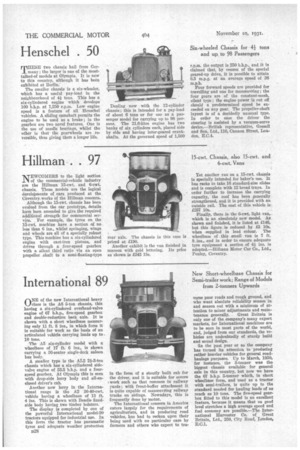Henschel . 50
Page 18

If you've noticed an error in this article please click here to report it so we can fix it.
MIIESE two chassis hail from Ger
many; the larger is one of the mosttalked-of models at Olympia. It is new to this country, although it has been exhibited at Berlin.
The smaller chassis is a six-wheeler, which has a useful pay-load in the neighbourhood of ft tons. This has a six-eylindered engine which develops 100 b.h.p. at 1,250 r.p.m. Low engine speed is a feature of all Henschel vehicles. A sliding camshaft permits the engine to be used as a brake; in the gearbox are two novel features. One is the use of needle bearings, whilst the other is that the gearwheels are reversible, thus giving them a longer life. Dealing now with the 12-cylinder chassis; this is intended for a pay-load of about 6 tons or for use as a passenger model for carrying up to 98 persons. The 21.6-litre engine has two banks of six cylinders each, placed side by side and having inter-geared crankshafts. At the governed speed of 1,500
r.p.m. the output is 250 b.h.p., and it is claimed that, by reason of the special geared-up drive, it is possible to attain 6.5 m.p.g. at an average speed of 36 m.p.h.
Four forward speeds are provided for travelling and one for raanceuvring; the four gears are of the constant-mesh, silent type; the engine power is cut off should a predetermined speed be exceeded on any gear. The propeller-shaft layout is of a decidedly unusual type. In order to ease the driver the steering is assisted by a vacuum-servo device.—British representative, Gossell and Son, Ltd., 110, Cannon Street, London, E.C.4.
















































































































































